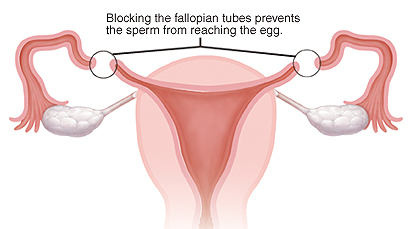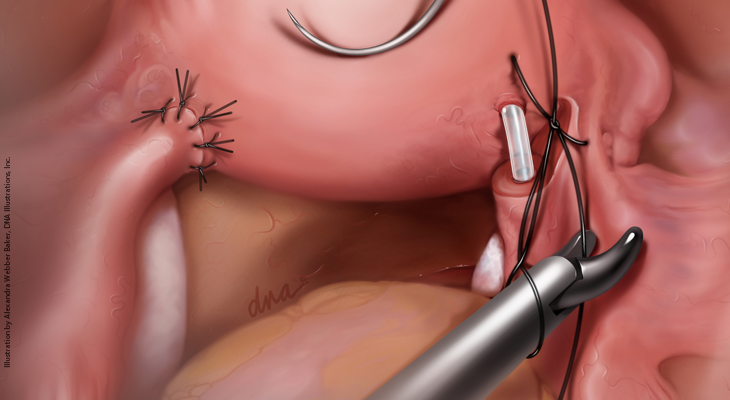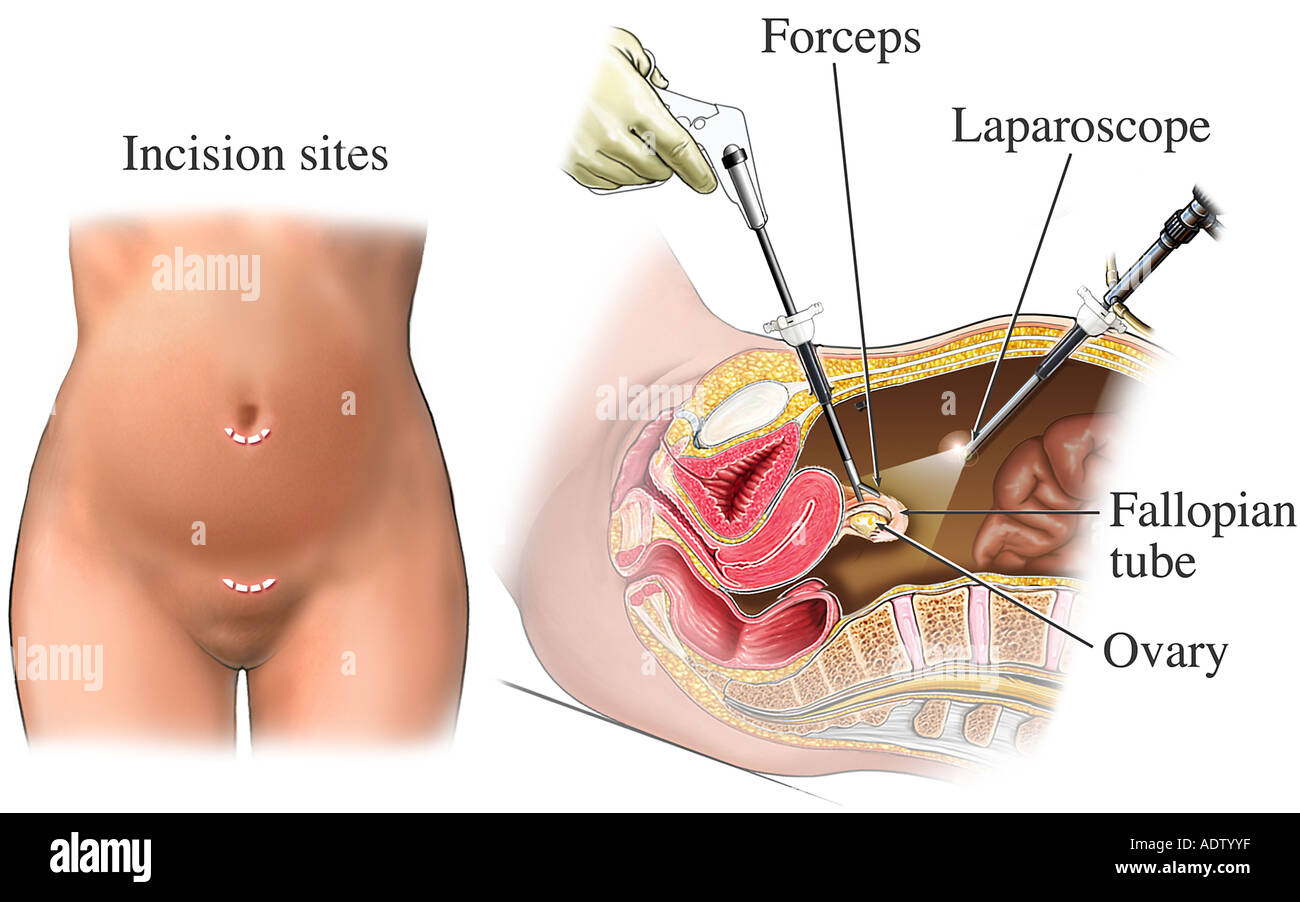The procedure may be done through a small incision just above the pubic hairline. For a laparoscopic tubal ligation the surgeon makes two small cuts incisionsone in or just below the belly button navel and one lower on your abdomen.
 Permanent Contraception Women S Health Issues Merck Manuals Consumer Version
Permanent Contraception Women S Health Issues Merck Manuals Consumer Version
Your doctor blocked tied cut or removed your fallopian tubes either by using laparoscopic surgery or open surgery.

Laparoscopic tubal ligation. Laparoscopic tubal ligation is a surgical sterilization procedure in which a womans fallopian tubes are either clamped and blocked or severed and. Periumbilical mini-laparotomy in which a segment of each tube is removed through a small incision in the umbilicus Pomeroy Parkland is the most commonly used procedure immediately following childbirth. You can go home on the same day and resume your normal activities within a few days.
WHILE YOU ARE HERE. Tubal ligation is a type of permanent birth control method that involves tying off the tubes. Through the use of a specialized tool called a laparoscope the doctor is able to view the inside of a womans abdomen and block the fallopian tubes thus preventing pregnancy.
For a laparoscopic tubal ligation the surgeon makes two small cuts incisionsone in or just below the belly button navel and one lower on your abdomen. Laparoscopy makes it possible to see and do the surgery through small incisions in the abdomen. The procedure can be done in hospital settings.
The abdominal cavity where the reproductive organs are is inflated with air or a harmless gas so that the surgeon can see and avoid injuring abdominal organs or the inside of the abdomen. Tubal ligation is a surgery done to close your fallopian tubes and prevent pregnancy. When tubal ligation is performed with a laparoscope a flexible tube with a camera it requires only three to four small keyhole-sized cuts on your lower belly near your navel to reach up to your tubes.
You may have pain in your belly for a few days after surgery. All laparoscopic sterilization techniques avoid the proximal 2 cm of the fallopian tube near the uterus. Laparoscopic Tubal Ligation Sterilization surgically induced infertility In women this can be accomplished by removing the uterus or ovaries separately or together or more commonly interrupting fallopian tubes laparoscopic tubal ligation.
Currently laparoscopic tubal ligation is the most popular method of female sterilization in non- pregnant women. Informed consent means you understand what will be done and can make decisions about what you want. 58600 Ligation or transection of the fallopian tube s abdominal or vaginal approach unilateral or bilateral The physician ties off the fallopian tube or removes a portion of it on one or both sides.
The fallopian tubes can be closed off by bands or clips. Laparoscopic tubal ligation is successful in preventing pregnancy in more than 99 out of 100 women. In laparoscopy an instrument called a laparoscope is inserted through a small incision made in or near the navel.
Another small incision may be made for an instrument to close off or remove the fallopian tubes. The fallopian tubes are cut or blocked which prevents pregnancy by blocking the eggs path to the sperm and uterus. Your doctor blocked tied cut or removed your fallopian tubes either by using laparoscopic surgery or open surgery.
Informed consent is a legal document that explains the tests treatments or procedures that you may need. A laparoscopic tubal ligation is surgery to close your fallopian tubes to prevent pregnancy. They also can be cut and closed with special thread or sealed with an electric current.
The abdominal cavity where the reproductive organs are is inflated with air or a harmless gas so that the surgeon can see and avoid injuring abdominal organs or the inside of the abdomen. A tubal ligation is considered a permanent method of birth control. For a laparoscopic tubal ligation the surgeon makes two small cuts incisionsone in or just below the belly button navel and one lower on your abdomen.
During the tubal ligation the fallopian tubes are cut tied or blocked to prevent pregnancy. A laparoscopic tubal ligation is surgery to close your fallopian tubes to prevent pregnancy. It is theorized that the proximal 1-2 cm of the fallopian tube is a reservoir for uterine.
Tubal ligation is a surgery done to close your fallopian tubes and prevent pregnancy. You may have pain in your belly for a few days after surgery. Blocking the fallopian tubes may prevent traveling of the eggs from the ovaries to the uterus and traveling of sperm up the fallopian tubes to the eggs.
 Laparoscopic Sterilization For Tubal Ligation Neway Hospitals Navi Mumbai Id 7120807248
Laparoscopic Sterilization For Tubal Ligation Neway Hospitals Navi Mumbai Id 7120807248

 Tubal Ligation What To Expect At Home
Tubal Ligation What To Expect At Home
 Laparoscopic Tubal Ligation Or Coagulation Sunnybrook Hospital
Laparoscopic Tubal Ligation Or Coagulation Sunnybrook Hospital
 Laparoscopic Tubal Ligation With Filshie Clips Youtube
Laparoscopic Tubal Ligation With Filshie Clips Youtube
 Laparoscopic Essure Tubal Reversal How We Do It
Laparoscopic Essure Tubal Reversal How We Do It
 Laparoscopic Tubal Ligation Stock Photo Alamy
Laparoscopic Tubal Ligation Stock Photo Alamy
 Laparoscopy Before Tubal Ligation Reversal
Laparoscopy Before Tubal Ligation Reversal
Tubal Ligation Laparoscopic Surgery Western New York Urology Associates Llc
 Tubal Ligation Laparoscopic Tubal Ring Sterilization Willis Knighton Health System Shreveport Bossier City Ark La Tex
Tubal Ligation Laparoscopic Tubal Ring Sterilization Willis Knighton Health System Shreveport Bossier City Ark La Tex
 Dr R K Mishra Explaining Laparoscopic Tubal Sterilization Youtube
Dr R K Mishra Explaining Laparoscopic Tubal Sterilization Youtube


No comments:
Post a Comment
Note: Only a member of this blog may post a comment.